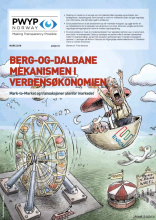- Marking-to-market is a concept which has started to invade a significant portion of both accounting and cross-border contracts. As a concept it is good, as it makes accounts more informative, but it also introduces problems.
- One of the problems is that it accelerates losses when markets collapses, and therefore constitute a risk of being one of the elements that make companies go bankrupt in a crisis. This can be avoided by changing the accounting guidelines for mark-to-market accounting.
- Another problem is that mark-to-market contracts, where the asset sits in another country, most often in a tax haven, creates the perfect opportunity for companies to transfer untaxed funds to tax havens, reducing taxes in the country where the company resides. The solution is to tax the mark-to-market profit through easily available mechanisms.
- Mark-to-Market is an accounting concept whereby an asset in the balance sheet is adjusted on a regular basis to its market value – normally upwards.
- The MtM-concept has spread to such a degree that it now governs the principles on most of the assets in the balance sheet and the income accrued from these.
- The MtM-concept usually entails one of two things: (1) In the current fiscal year, an unrealized revenue item is recognized, which means that two financial statements that is comparable in all other aspects, cannot be compared anymore, and (2) used between companies in multinational corporations, the concept can transfer untaxed capital to a large extent to subsidiaries in the low-tax country.
- The problem with (1) is that companies that pay too much dividends based on unrealized income items become less solid and more vulnerable to cyclical fluctuations, while the problem of (2) is that it is a de facto method of transferring untaxed capital out of a country, much referred to as capital flight.
Written by
Frian Aarsnes
Publication date
ISBN
978-82-93212-79-9
File
| Attachment | Size |
|---|---|
| Les rapporten på norsk.pdf | 759.29 KB |
File
| Attachment | Size |
|---|---|
| Les rapporten på engelsk.pdf | 1.02 MB |

